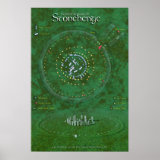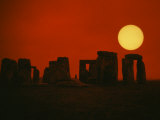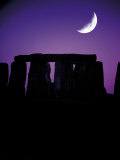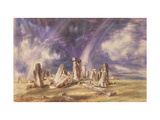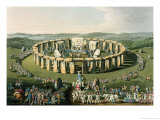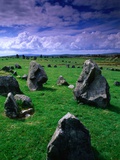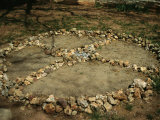Stonehenge Educational Art Prints & Posters |
||
|
social studies > history > mandala > STONEHENGE < astronomy |
||
|
Stonehenge is one of the most important and visited prehistoric monuments in Britain. What we see today was completed about 3500 years ago. The stones are composed of bluestones from the Preseli Mountains in southwest Wales. They weigh up to 4 tons each and were dragged on rollers and floated on rafts on their 240 mile journey. The larger stones are sarsen stones, which were probably brought from Marlborough Downs near Avebury, about 20 miles north of Stonehenge. The largest stone weighs 50 tons and would have required 500 men to pull it. Stonehenge, the Big Horn Medicine Wheel, and other such structures attest to the importance of tracking the Sun as it moves across the sky; sowing of seed, hunting of game, and other events were planned in accordance with the sun’s actions. For millennia, cultures have noted the lengthening of days as summer progresses, and celebrated the longest day of the year, after which the sun returns to the Earth and the days become shorter. Although we now know that the solstice itself is caused by the movement of Earth in an orbit that is tilted 23.5 degrees to the direction of the equator (this tilt results in constantly changing solar illumination at Earth’s different latitudes), the change of seasons is no less awe-inspiring. |
||
|
Great Britain | architecture | seasons | natural monoliths |
||
|
||||
|
|
||||
|
||||
|
|
||||
|
||||
|
|
||||
|
||||
|
|
||||
|
|
||||
previous page | top
|
I have searched the web for visual, text, and manipulative curriculum support materials - teaching posters, art prints, maps, charts, calendars, books and educational toys featuring famous people, places and events - to help teachers optimize their valuable time and budget. Browsing the subject areas at NetPosterWorks.com is a learning experience where educators can plan context rich environments while comparing prices, special discounts, framing options and shipping from educational resources. Thank you for starting your search for inspirational, motivational, and educational posters and learning materials at NetPosterWorks.com. If you need help please contact us. |
|
NPW home | Global PathMarker Collection | APWTW Blog | faqs-about | contact | search | privacy |
|
NetPosterWorks.com ©2007-2015 The Creative Process, LLC All Rights Reserved. |
last updated









